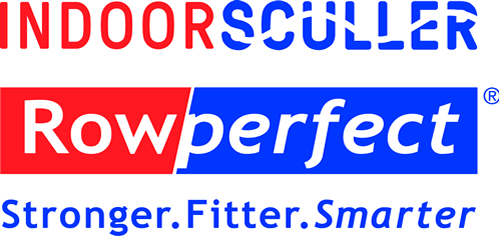Why 17kg is so important?
Indoor Sculler, the only boat-weight matched rowing machine
Rowperfect
FIXED ERGS ARE DAMAGING
The ergonomics of fixed head rowing machines require up to 90% of the rower’s leg strength to be used to reverse body momentum at the catch, compressing knee cartilage. At the finish the reverse occurs to stop the body rocketing backwards – the result is a massive jerk on the hip flexors, placing compressive and shear forces on the lower spine.
In contrast, WHETHER YOU’RE IN A BOAT OR ON THE INDOORSCULLER,
the maximum leg strength used is 10%. Force required is directly proportional to the mass of the boat: the heavier the boat the more power required to reverse the body momentum – our machine weighs 17 kilograms; so exactly the same as a racing scull with its oars, or a rower’s portion of a crew racing boat, whereas a fixed head rowing machine mimics a boat weighing several tonnes!
Thus the result of a fixed machine’s ergonomics is diametrically opposite in terms of muscle and nerve control, with major attendant injury risk, and additionally the coordination pattern and muscle power to take a stroke is very different to that required in the boat.
It’s also easy to explain why you end up producing more power from your knee than your hip on a FIXED ERG – a stationary erg gives you a score based on how quickly you straighten your knee, so you use your quads way too much and reduce the power from your gluts and hamstrings.
Research at Sydney University has clearly shown that the power produced goes from 3:1 hip:knee (in boat or on our machine) to 1:3. So there’s a MAJOR DIFFERENCE, likely to result in reduced hamstring and gluteal development thus rendering the user even more prone to back injury, and at the same time rewarding a hard kick at the catch with a good score.
CONSEQUENCES
The injury risks associated with fixed flywheel ergometers almost pale into insignificance when compared to what happens to the brain as the rower moves up and down the slide, with the brain bouncing back and forth inside their skull.
It’s actually very interesting to sit a bowl of jelly on the seat of any fixed ergometer and move it up and down the slide at rate 30 – you see exactly what your brain is doing when you row on one (in fact your brain moves further than the slide as the movement of your trunk adds about 30cm to the movement range of the head)
Compare that to the gentle rocking movement of the head in a racing boat or on the IndoorSculler: the head moves a maximum of 30cm per stroke; the rower can’t use anchored feet as happens on a fixed ergometer to jerk the body to a stop at the finish, so deceleration must be smooth and coordinated.
The result is a smooth, rhythmic and satisfying motion – rowing as it’s meant to be.
Satisfaction Guaranteed
I’ve had such good work with the sculler that I would like to keep it for the month of April. Several of my best rowers are responding nicely to elements of the stroke that I can’t anywhere else off the water. This version of the RP is terrific.
“This is great Mark. I am still enjoying it and you are right, so much more than the Concept 2 (market-leading rowing machine).”
Satisfied
Head Office
2/4 Moore Road,
Freshwater NSW 2096
